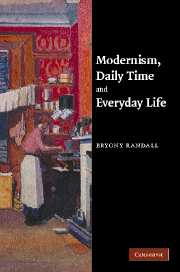Book contents
- Frontmatter
- Contents
- Acknowledgements
- List of abbreviations
- Introduction: dailiness
- Chapter 1 The contemporary context: Henri Bergson and William James
- Chapter 2 Dailiness in Dorothy Richardson's Pilgrimage
- Chapter 3 Re-creation, work and the everyday in Gertrude Stein
- Chapter 4 War-days: H.D., time and the First World War
- Chapter 5 Reading, writing and thinking: a Woolfian daily life
- Afterword
- Notes
- Bibliography
- Index
Chapter 5 - Reading, writing and thinking: a Woolfian daily life
Published online by Cambridge University Press: 22 September 2009
- Frontmatter
- Contents
- Acknowledgements
- List of abbreviations
- Introduction: dailiness
- Chapter 1 The contemporary context: Henri Bergson and William James
- Chapter 2 Dailiness in Dorothy Richardson's Pilgrimage
- Chapter 3 Re-creation, work and the everyday in Gertrude Stein
- Chapter 4 War-days: H.D., time and the First World War
- Chapter 5 Reading, writing and thinking: a Woolfian daily life
- Afterword
- Notes
- Bibliography
- Index
Summary
INTRODUCTION: ‘WHAT IS LIFE?’ – OSCILLATION AND DAILINESS
‘[T]o find a literary form for the representation of daily life, or to put the whole of “life” into a single day (Mrs Dalloway, Between the Acts) is exactly what Woolf attempts to achieve in her novels’. Rachel Bowlby puts forward this critical assessment of Virginia Woolf's literary aims in her important collection of essays, Feminist Destinations. But appearing, as it does, only parenthetically (within a chapter on ‘Orlando's Undoing’), this statement reflects the heretofore parenthesised, inadequately theorised, question of the daily in modernist writing. My intention in this chapter is to take seriously this proposition – remove it from its parentheses. Exploration of these two approaches to dailiness in Woolf, the ‘representation of daily life’, and the idea of putting ‘the whole of “life” into a single day’, will form the two main sections of this chapter. In particular, I will suggest how the processes of thinking, writing, and in particular reading – both as they are explicitly addressed in Woolf's work, and in terms of how her work modifies and expands upon our understanding of these processes as part of the production of the text itself – form part of a particularly Woolfian understanding of that in which ‘daily life’ consists. As Hermione Lee says, ‘Reading, quite as much as writing, is [Woolf's] life's pleasure and her life's work.
- Type
- Chapter
- Information
- Modernism, Daily Time and Everyday Life , pp. 155 - 184Publisher: Cambridge University PressPrint publication year: 2007



